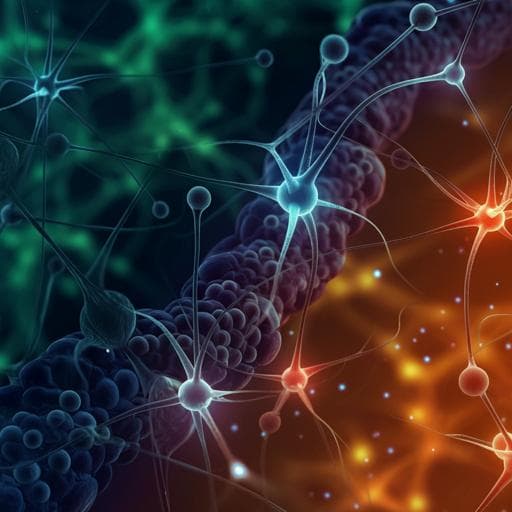
Medicine and Health
Gut microbiota-derived tryptamine and phenethylamine impair insulin sensitivity in metabolic syndrome and irritable bowel syndrome
L. Zhai, H. Xiao, et al.
This groundbreaking research reveals a direct link between *Ruminococcus gnavus*-derived compounds, tryptamine and phenethylamine, and insulin resistance in individuals with IBS and type 2 diabetes. Conducted by an expert team from Hong Kong Baptist University and Rutgers University, these findings open new avenues for potential therapeutic interventions targeting the TAAR1 signaling axis.
~3 min • Beginner • English
Introduction
Irritable bowel syndrome (IBS) is a common functional bowel disorder characterized by altered bowel habits and recurrent abdominal pain. Recent studies indicate IBS is associated with a higher prevalence of metabolic syndrome and type 2 diabetes (T2D), suggesting IBS may be a risk factor for metabolic disorders. The gut microbiome has been implicated both correlatively and causally in metabolic conditions (metabolic syndrome, insulin resistance, diabetes) and gastrointestinal disorders such as IBS. Thus, IBS-related gut dysbiosis may contribute to metabolic dysfunction, but the specific pathogenic factors and molecular mechanisms remain unclear. Prior work shows that changes in gut microbiota can alter levels of microbial products (lipopolysaccharides, short-chain fatty acids, bile acids, TMAO, imidazole propionate) affecting glucose tolerance. Gut microbes also catabolize dietary aromatic and branched-chain amino acids into metabolites influencing host metabolism. The IBS-associated bacterium Ruminococcus gnavus produces tryptamine and phenethylamine from dietary tryptophan and phenylalanine and can induce diarrheal symptoms. R. gnavus has also been associated with features of metabolic syndrome, but causality and mechanisms were unknown. This study investigates whether R. gnavus-derived tryptamine and phenethylamine contribute causally to insulin resistance in IBS and T2D, elucidates the underlying signaling pathway (TAAR1–ERK), and evaluates whether targeting this axis mitigates dysbiosis-induced insulin resistance. It also examines whether dietary fiber intervention suppresses these metabolites alongside improvements in insulin sensitivity, thereby linking IBS-associated dysbiosis to metabolic syndrome risk.
Literature Review
The paper situates its work within evidence that gut microbiota alterations influence host glucose homeostasis via microbial metabolites such as LPS, SCFAs, bile acids, TMAO, and imidazole propionate, impacting insulin sensitivity in animals and humans. Aromatic amino acids are metabolized by gut bacteria into bioactive compounds; prior research identified Ruminococcus gnavus as an IBS-associated producer of tryptamine and phenethylamine from tryptophan and phenylalanine, contributing to diarrhea. Cross-sectional human data (HUNT study) associated R. gnavus with metabolic syndrome features (elevated triglycerides and HbA1c). However, the causal role of R. gnavus and these amines in insulin resistance and the specific receptor-mediated mechanisms had not been delineated. TAAR1 is known to be activated by trace amines including tryptamine and phenethylamine and to engage MAPK/ERK signaling; ERK activation has been linked to insulin resistance. These prior findings underpin the study’s hypotheses.
Methodology
The study integrates human cohorts, nonhuman primate models, mouse models (including germ-free, antibiotic-treated, and gene knockout), in vitro adipocyte assays, microbial engineering, and targeted metabolomics/proteomics.
- Human cohorts: (1) IBS patients and healthy controls (HC) with fasting blood glucose (FBG), triglycerides (TG), TyG index, and shotgun metagenomics to examine R. gnavus abundance and correlations with TyG; (2) T2D patients vs normal glucose tolerance (NGT) controls with fecal quantification of tryptamine, phenethylamine, and precursors (tryptophan, phenylalanine); (3) GUT2D dietary fiber intervention trial (acarbose+WTP diet vs control) with fecal tryptamine/phenethylamine levels and correlations with HbA1c and HOMA-IR; TDC gene presence in bacterial genomes was analyzed.
- Nonhuman primates: Age-matched Macaca fascicularis classified as normal, pre-diabetes, or diabetes by FBG and HbA1c. Targeted LC-MS quantified serum and fecal tryptamine/phenethylamine and precursors; correlations with FBG/HbA1c assessed. Batch culture of feces assessed microbial capacity to produce tryptamine/phenethylamine. An intervention IVGTT tested the effect of oral tryptamine (10 mg/kg) on glucose tolerance.
- Mouse models: Germ-free mice monoassociated with R. gnavus (ATCC 29149) to test effects on OGTT/ITT and to quantify serum/fecal tryptamine/phenethylamine. Antibiotic-treated mice colonized with engineered Lactobacillus casei expressing R. gnavus tryptophan/phenylalanine decarboxylase (TDC) vs vector control; OGTT/ITT and metabolite levels measured. Acute administration of tryptamine or phenethylamine at pathophysiological doses; OGTT/ITT performed; insulin-stimulated AKT phosphorylation assessed in insulin-sensitive tissues (WAT, liver, skeletal muscle) by Western blot. ERK pathway involvement tested using inhibitors U0126 and PD98059. TAAR1 involvement tested with antagonist EPPTB and with Taar1 knockout mice generated by CRISPR/Cas. Fecal microbiota transplantation (FMT) from IBS patients with high TyG and high tryptamine/phenethylamine into antibiotic-treated mice, with and without TAAR1 inhibition or Taar1 deletion. Fecal suspensions from diabetic vs normal monkeys administered to HFD-fed mice for OGTT.
- In vitro assays: 3T3-L1 adipocytes used to assess time- and dose-dependent effects of tryptamine/phenethylamine on insulin signaling (AKT phosphorylation) and ERK activation, glucose uptake, and modulation by ERK inhibitors and TAAR1 antagonist EPPTB. Controls included precursors and downstream metabolites (tryptophan, phenylalanine, indole-3-acetic acid, phenylacetic acid). Additional receptor pathway controls tested antagonists for AhR and 5-HT4.
- Targeted metabolomics: LC-MS/MS (UPLC-QQQ) quantified tryptamine, phenethylamine, tyramine and their precursors in feces and serum; defined gradients and MRM transitions; quality controls included pooled QC samples.
- Phosphoproteomics: TMT-labeled phosphoproteomics of WAT after tryptamine gavage to identify altered phosphorylation of proteins (e.g., ERK/MAPK components), with KEGG pathway annotation.
- Statistics: Parametric and non-parametric tests as appropriate (t-tests, ANOVA, Wilcoxon), Spearman correlations, significance at p<0.05. Note: for basic experiments, no predetermined sample size, non-randomized, and not blinded.
Key Findings
- IBS cohort: IBS patients exhibited higher FBG, TG, and TyG index than healthy controls (all p ≤ 0.001). R. gnavus abundance positively correlated with TyG in both HC (r=0.200, p=0.034) and IBS (r=0.186, p<0.001), and was enriched in IBS with higher TyG. Fecal tryptamine and phenethylamine correlated with TyG (r=0.196 and 0.255, both p<0.001) and were elevated in IBS with higher TyG.
- Causality in mice: Germ-free mice monoassociated with R. gnavus showed impaired glucose tolerance and reduced insulin sensitivity (OGTT/ITT, p<0.05) with elevated serum and fecal tryptamine/phenethylamine (p≤0.01). Antibiotic-treated mice colonized with engineered L. casei expressing R. gnavus TDC had increased tryptamine/phenethylamine production (in vitro and in vivo) and displayed worsened OGTT/ITT vs vector controls (p<0.05).
- T2D humans and monkeys: T2D subjects had higher fecal tryptamine (p=0.011) and phenethylamine (p=0.031), while precursors (tryptophan, phenylalanine) and tyramine were not significantly altered. In T2D, fecal tryptamine and phenethylamine positively correlated with FBG (r=0.443, p=0.005; r=0.378, p=0.008). In Macaca fascicularis, diabetic animals had higher serum and fecal tryptamine/phenethylamine (all p<0.05) with positive correlations to HbA1c (r≈0.245–0.253, p<0.05) and FBG (serum/fecal: r=0.452/0.275 for tryptamine; r=0.368/0.255 for phenethylamine, p<0.02). Fecal batch cultures from pre-diabetic/diabetic monkeys produced more tryptamine and phenethylamine (p=0.006 and 0.02). Fecal suspensions from diabetic monkeys induced higher glucose in recipient mice vs normal donors (p<0.05).
- Dietary fiber intervention (GUT2D): R. gnavus CAG0075 (harboring TDC) was suppressed by high-fiber diet. Fecal tryptamine and phenethylamine and their ratios to precursors were reduced in the high-fiber group (W) after 84 days (p=0.001). Reductions correlated with improvements in HbA1c and HOMA-IR (tryptamine: r=0.569 and 0.544; phenethylamine: r=0.269 and 0.356 after BMI adjustment; all p<0.05).
- Direct metabolic effects: Acute tryptamine or phenethylamine administration impaired glucose tolerance and insulin sensitivity in mice (dose-dependent OGTT/ITT, p<0.05) and tryptamine impaired glucose tolerance in monkeys (IVGTT, p<0.05). Both amines reduced insulin-stimulated AKT phosphorylation in WAT, liver, and skeletal muscle (p<0.05) and elevated serum TG; serum insulin increased in treated mice and monkeys (p<0.01).
- Mechanism: Tryptamine entered insulin-sensitive tissues rapidly and phosphoproteomics implicated ERK/MAPK activation. In vivo, tryptamine and phenethylamine increased ERK1/2 phosphorylation in insulin-sensitive tissues and suppressed insulin-stimulated AKT phosphorylation. ERK inhibitors (U0126, PD98059) improved OGTT/ITT and restored AKT signaling in amine-treated mice and blocked ERK activation in 3T3-L1 cells. TAAR1 antagonist EPPTB attenuated tryptamine/phenethylamine-induced glucose intolerance and insulin resistance, reduced ERK phosphorylation, and restored AKT signaling in vivo and in vitro. Taar1 knockout mice were protected from amine-induced glucose intolerance/insulin resistance and from FMT-induced glucose intolerance from IBS donors with high TyG and high tryptamine/phenethylamine. EPPTB also alleviated R. gnavus-induced insulin resistance in colonized antibiotic-treated mice.
- Specificity controls: Precursors (tryptophan, phenylalanine) and metabolites (indole-3-acetic acid, phenylacetic acid) did not impair insulin signaling in 3T3-L1 cells; IAA did not impair glucose tolerance or insulin sensitivity in mice. GLP-1 and PYY levels were unaffected by acute amine treatment. AhR or 5-HT4 antagonists did not block tryptamine-mediated ERK activation, implicating TAAR1 predominance. Inhibition of peripheral serotonin synthesis did not alter acute tryptamine effects on glucose tolerance.
Discussion
The study demonstrates a causal link between IBS-associated gut dysbiosis—specifically Ruminococcus gnavus-derived tryptamine and phenethylamine—and insulin resistance relevant to metabolic syndrome and T2D. Associations are consistent across humans and a spontaneous nonhuman primate model, reducing confounding common in human microbiome studies. Mechanistically, the data support a TAAR1–MAPK/ERK signaling axis in insulin-sensitive tissues as the pathway by which tryptamine and phenethylamine suppress insulin signaling (reduced AKT phosphorylation), yielding glucose intolerance and insulin resistance. Pharmacological inhibition of ERK or TAAR1, and genetic ablation of Taar1, mitigated these effects, establishing pathway specificity and suggesting therapeutic potential. Dietary fiber intervention suppressed R. gnavus (TDC-positive) and reduced fecal tryptamine/phenethylamine, correlating with improved insulin sensitivity, indicating microbiome-targeted therapies may be effective. The findings reconcile elevated insulin secretion from TAAR1 activation with systemic insulin resistance, emphasizing careful consideration of TAAR1 modulators in glycemic control strategies. The work provides mechanistic insight into the increased prevalence of metabolic syndrome in IBS and highlights gut microbial aromatic amines as comorbid factors linking gastrointestinal and metabolic disorders.
Conclusion
Ruminococcus gnavus-derived tryptamine and phenethylamine causally impair insulin sensitivity and glucose control via TAAR1–ERK activation in insulin-sensitive tissues, providing a mechanistic basis for the higher prevalence of metabolic syndrome in IBS and implicating these microbial metabolites as comorbid factors in IBS and T2D. Suppression of R. gnavus and these amines by dietary fiber correlates with improved insulin sensitivity, and pharmacological or genetic disruption of TAAR1 signaling mitigates dysbiosis-induced insulin resistance. These results suggest TAAR1 and its downstream ERK pathway as therapeutic targets and support microbiome-based interventions (e.g., dietary fiber modulation) to manage metabolic dysfunction linked to gut dysbiosis. Future studies should quantify the relative contribution of these metabolites across diverse cohorts and regions and evaluate translational strategies for targeting the tryptamine/phenethylamine–TAAR1 axis.
Limitations
- Human components are observational for association; although multiple animal models support causality, direct interventional causality in humans was not tested.
- Basic experiments were not randomized, investigators were not blinded, and sample size was not predetermined, which may introduce bias.
- Potential confounders in human microbiome studies (age, medications, diet) were addressed in part by using treatment-naive primates, but residual confounding in human cohorts may remain.
- While TAAR1 predominance was supported, contributions of other pathways (e.g., serotonin modulation) to chronic metabolic phenotypes cannot be fully excluded.
- Generalizability across diverse populations and microbiome ecologies requires further validation.
Related Publications
Explore these studies to deepen your understanding of the subject.







